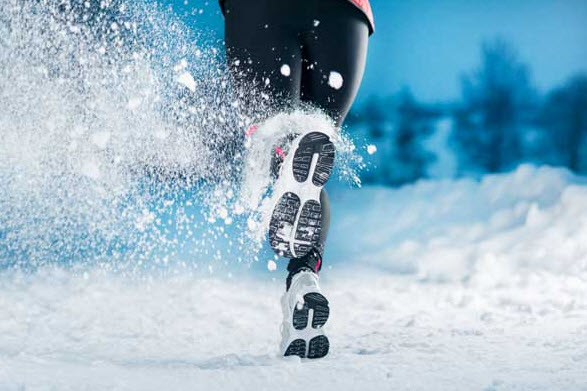Fall (and winter!) are right around the corner, and while it’s tempting to huddle up on the sofa on cold days, arthritis knows no season. A lack of activity can cause your joints to become stiff, so move it or lose it. Exercise eases arthritis pain, increases strength and flexibility, and boosts your energy. Studies show that people with arthritis and related diseases – including osteoarthritis, rheumatoid arthritis, psoriatic arthritis and fibromyalgia – benefit from regular exercise. Exercise lessens pain and improves your overall quality of life.
Our Jingle Bell Run events are right around the corner, and whether you’re prepping to participate in our 5K, or exercising in your neighborhood, taking a few simple precautions can help control your arthritis pain and keep you active and outdoors throughout the colder months.
Time it right
Joint stiffness is usually worse when you first wake up, making an early morning workout uncomfortable and painful. Take your walk later in the day when it’s warmer outside and your joints have loosened up. Plus, if you’re taking pain medications it gives them a chance to kick in before you exercise. To warm up joints faster try popping your workout clothes in the dryer for five minutes while you get ready.
Dress in loose layers
Dress in comfortable layers that you can take off as you warm up and put on (or zip back up) at the end, says Nader Nassif, MD, orthopedic surgeon with Hoag Orthopedic Institute in Irvine, California. Loose layers trap body heat and keep joints warm. Be careful not to overdress, however. “After your warm up, you can potentially become overheated if you are wearing too many layers,” says Dr. Nassif. In general, start with a thin synthetic layer (not cotton), add a layer of fleece, and top with a waterproof, breathable outer layer.
Drink up
Hydration is most often associated with sweat and the summer months, but it’s just as important to drink plenty of water in winter, too. You still sweat and lose fluid in cold weather, says Dr. Nassif. “Make sure you stay hydrated before, during and after your workout.” Dehydration can affect mood and even brain function. In general, drink about 16 ounces (two cups) of water two hours before a workout.
Protect your extremities
Working out in cold weather exposes your hands, feet, ears and nose to severe temperatures. “If you suffer from Raynaud’s use chemical hand warmers in your gloves and boots,” says Nathan Wei, MD, director of the Arthritis Treatment Center in Frederick, Maryland. “And wear mittens instead of gloves since they keep your hands warmer.” A hat or beanie is ideal for keeping your ears covered and reduces the amount of heat you lose from the top of your head.
Wear sunblock
Don’t let cold weather deceive you: Sunny winter days are just as likely to result in sunburn, says Dr. Nassif. This is especially true if you have psoriasis or lupus, or if you take NSAIDs or methotrexate, which can make your skin more sensitive to the sun. “Make sure you wear appropriate sunscreen (SPF 50) on exposed parts and protect your eyes with sunglasses or ski goggles.” Remember to reapply if you’re sweating or after more than two hours outdoors. Include a soothing lip balm with sunscreen to prevent windburn and sunburn as well.
Get traction
Ice isn’t the only danger when walking or exercising outdoors. Packed snow can also make you lose your footing and cause a fall. “Look for ways to get added traction,” says Tom Holland, Connecticut exercise physiologist and 23-time Ironman triathlete. He recommends simple cleats you strap on to your shoes that provide traction when walking on ice or snow. Trail shoes also provide more grip and stability than running or walking shoes made for the road, without buying special equipment.
Safety first
Always bring a phone and let people know where you’re going, says Holland. “If you slip or fall while walking or biking it’s a good idea someone knows where they can find you.” In addition, choose a neighborhood that’s familiar to you, so if large snowbanks or road detours prevent you from taking your regular route you know how to find your way back home, Holland adds.
Warm up and cool down
Before you go outside spend a few minutes warming up, which is especially important when you have arthritis, says Holland. “The goal is to warm up your core. This helps loosen up your joints and gives your muscles added flexibility.” Warm up by marching in place or on a treadmill for five to 10 minutes at a slow-comfortable pace and then stretching out all major muscle groups. After your workout, take time to cool down and stretch out afterward as well.
Think low-impact
Cardiovascular exercise does not have to include high-impact exercise such as skiing, jogging or running. In fact, Dr. Wei recommends low-impact exercise such as snowshoeing, cross country skiing or walking. These sports are not only easier on the joints but provide all the many benefits of physical activity.
Take it inside
On the coldest winter days it’s best to work out indoors where you can control the environment better, says Wei. Walk at the mall, hop on a stationary bike, go for a swim at the local aquatic center or take an exercise class at the gym. According to the American College of Sports Medicine, cold weather itself should not be a barrier to exercising outdoors, especially if you are accustomed to it. However, those with Raynaud’s syndrome, heart disease or asthma are at highest risk of being impacted by the cold and may need to avoid outdoor exercise in frigid temperatures altogether.






